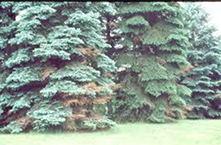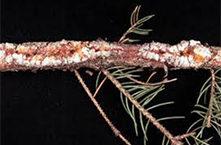Spruce tree, Douglas Fir, Balsam Fir, Eastern Hemlock, Larch, Pine.
DESCRIPTION AND LIFECYCLE:
The stem disease Cytospora Canker is an opportunistic pathogen and a stress-related disease. The fungus usually infects trees that are weakened by environmental stress factors such as drought, incorrect planting, poor soil conditions, compaction, over watering and lawnmower damage. Blue Colorado Spruce are most commonly affected, but it also attacks other conifers. Infection usually begins when trees are at least 10-15 years old. The fungus gains entry through wounds. The infection usually starts on the lower branches and spreads upwards as spores of the fungus are dispersed by rain-splash. Needles on infected branches first turn purple, then brown and drop, leaving the infected branches bare. Cankered branches are usually covered with white resin. Black, pinhead-size fruiting bodies or pycnidia in the dead inner bark of infected branches are positive signs of the disease. The disease does not kill the tree instantly. Several years or sometimes decades may pass before the trunk or large limbs are completely girdled. The fungus overwinters in the infected branches. There is no effective cure for this disease however it may be controlled by improving tree vigor so that the tree’s own defense system can reduce the spread of the infection. Infected branches cannot be saved. It should be noted that the damage caused by this pathogen is rarely restored. Management practices that enhance health are employed in the hopes of arresting and reducing the further spread of the disease in the tree.
CONTROL MEASURES:
- Prune and remove infected branches. Infected branches should be pruned back to the main stem. Prune only when it is dry to prevent further infections. Avoid spring pruning. Pruning tools need to be disinfected.
- Avoid stem and bark injuries. Wounds made by improper pruning of lower braches to open space around the base of the tree are the most common entry points for the fungus.
- Improve channels for air and water drainage in the soil to alleviate compaction and poor drainage issues by performing aeration with vertical mulching and root crown excavations.
- Fertilize with a slow release acid evergreen fertilizer high in nitrogen and potassium.
- During periods of hot dry weather provide a deep soaking once a week from the trunk of the tree out past the dripline.
- Caution: Do not overwater Spruce trees. Use proper planting techniques.



